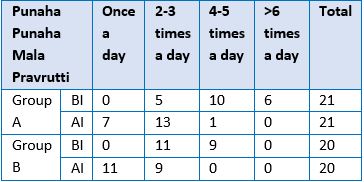A controlled clinical trial to evaluate the efficacy of Shalaparnyadi Kwatha in the management of Vataja Grahani
DOI:
https://doi.org/10.21760/jaims.7.9.3Keywords:
Samana Vayu, Apana Vayu, Pachaka Pitta, Punaha Punaha Mala Pravrutti, Deepaneeya GunaAbstract
Background: Current mechanized life, irregular dietary patterns, irregularity in daily practices, junk food indulgence, stressful life, over usage of pesticides and chemicals leads to various gastro intestinal disorders. These factors hamper the digestive capacity of individuals and develop the disease Grahani. Shalaparnyadi Kwatha mentioned in treatment of Vataja Grahani in Sharangadhara Samhita is taken up for study in the management of Vataja Grahani. Objective: To evaluate the efficacy of Shalapanryadi Kwatha in Vataja Grahani. Method: The study was a double arm open labelled controlled clinical trial with pre and post-test study design. There were total of 41 subjects involved in the study and were divided into two groups - Group A (trial group) with 21 subjects and Group B (controlled group) with 20 subjects. Group A was administered with Shalaparnyadhi Kwatha and Panchamooladya Choorna and Group B was administered with Panchamooladya Choorna for 30 consecutive days. Result: A controlled clinical study was conducted on subjects of Vataja Grahani with Shalaparnyadi Kwatha and Panchamooladya Choorna in trial group and Panchamooladya Choorna in control group both the interventions were effective in management of Vataja Grahani. Based on the mean value and statistically significant difference between the groups, trial group showed better result than control group in Amayukta Mala Pravrutti and Udara Shoola. Conclusion: It can be concluded from the results that added effect of Shalaparnyadi Kwatha with Panchamooladya Choorna is more effective than Panchamooladya Choorna alone.
Downloads
References
Acharya J T, editor, 2016, Nibandhasangraha commentary of Sri Dalhanaacharya on Sushruta Samhita of Sushruta Uttaratantra; Atisaraprathishedadhyaya :chapter 40, verse 166. Varanasi: Chaukamba Sanskrit Sansthan, 2016; p709.
Anna moreshwara kunte, 9th Ed, Astanga Hridaya of Vagbhata Shreerasthana,; Angaprathyangavignyaniy adhyaya: chapter 3, verse 53.Varanasi: Chaukambaorientalia ; p394.
Acharya Y T, editor, 2016, Ayurvedadipika commentary of Sri Chakrapanidatta on Charakasamhita of Agnivesha, Chikitsasthana; Grahanidoshachikistita adhyaya: chapter 15, verse 60-64. Varanasi; Chaukamba orientalia, 2016; p518
Prof.K.R. Srikanthamurthy, 9th Ed, Sharangadhara Samhita of Sharangadhara, Madyamakhanda; chapter 2, verse 71. Varanasi; Chaukamba orientalia, p64
Mahesh, Ayyavu and Jeyachandran, Robert and Rao, Dowlathabad Muralidhara and Thangadurai, Devarajan (2012) Gastroprotective effect of Desmodium gangeticum roots on gastric ulcer mouse models. Revista Brasileira De Farmacognosia Brazilian Journal of Pharmacognosy, 22 (5). pp. 1085- 1091
Philip BK, Muralidharan A, Natarajan B, Varadamurthy S, Venkataraman S. Preliminary evaluation of anti-pyretic and anti-ulcerogenic activities of Sida cordifolia methanolic extract. Fitoterapia. 2008 Apr;79(3):229-31. doi: 10.1016/j.fitote.2008.01.001. Epub 2008
Brijesh, S., Daswani, P., Tetali, P. et al. Studies on the antidiarrhoeal activity of Aegle marmelos unripe fruit: Validating its traditional usage. BMC Complement Altern Med 9, 47 (2009).
Singh, Dr Purnima & Guha, Debjani. (2012). Aegle Marmelos Enhances Gastric Mucosal Protection: Relevance for NSAIDS-Induced Gastric Mucosal Injury.
Hu ML, Rayner CK, Wu KL, Chuah SK, Tai WC, Chou YP, Chiu YC, Chiu KW, Hu TH. Effect of ginger on gastric motility and symptoms of functional dyspepsia. World J Gastroenterol. 2011 Jan 7.
Emamghoreishi M, Khasaki M, Aazam MF. Coriandrum sativum: evaluation of its anxiolytic effect in the elevated plus-maze. J Ethnopharmacol. 2005 Jan
Bansal, Parveen. (2010). Phytochemistry and pharmacological activities of Haritaki – A review















